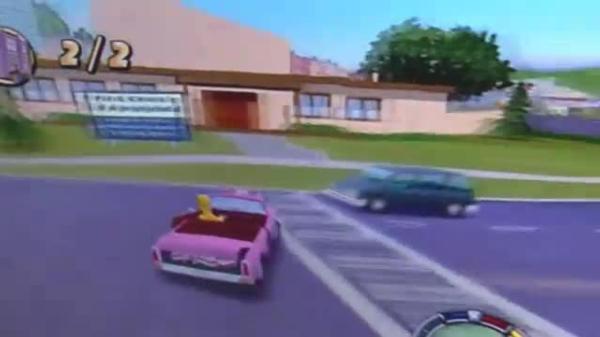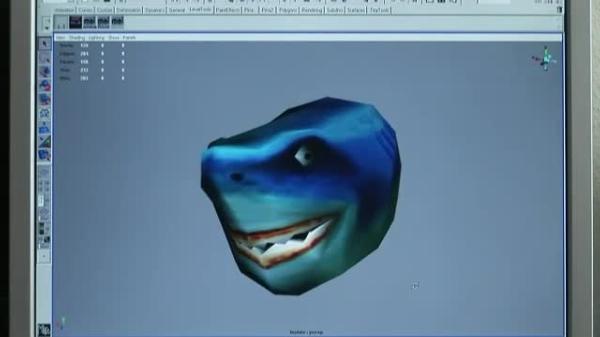Computerspiele
Virtuelle Welten

Computer Games

1. Virtual World of Games 1.1 The Triumphal Advance of Computer Games Virtual empires which have to be created and conquered, racing cars that skid around narrow bends as fast as lightning without endangering life and limb, cheeky moorhens which are shot down, falling stones that must be moved into the right position - we cannot imagine every-day life without computer games today. Portable game consoles have long become our faithful companions - always and everywhere. But computer games don't just take up a large part of our leisure time, meanwhile they have become a gigantic economic factor. All over the world more money is turned over today with computer and video games than with feature films; about 18.8 billion euros a year. Well-known game designers like Shigeru Miyamoto, the inventor of the popular Zelda series, are feted like heroes and their games are sold out so quickly that they have to be ordered in advance. It is Microsoft boss Bill Gates himself who promotes the Xbox-360-game system: Original soundtrack Such commitment is no great wonder: in 2005, for example, the turnover of the computer game industry went up 4% to 1.3 billion euros with its software sales alone. Two new trends add new impetus to the market of electronic games: online games and games for mobile phones Many games are based on already successful fantasy or science-fiction books like Lord of the Rings. As a countermove some PC games have reached such degrees of popularity that they were even made into cinema films like, for example Tomb Raider. 1.2 Fascination Computer Games For a long time already millions of children, adolescents and grown-ups have ardently called computer games their hobby. In the virtual world they can adopt other people's roles. They possess supernatural abilities and can make experiences and mistakes without any real consequences. And the computer follows their orders. In the game they measure their strength with friends. Who collects more credits? Who can reach the higher level? Several online-multiplayer games such as World of Warcraft, have a whole fan community grow around them, whose members can communicate in chatrooms within the games. Here it is clearly recognizable that for many players it is above all the common game experience which is of prime importance. Quite often a thrilling game captivates an individual to such an extent that he is no longer aware of anything around him, is completely cut off from the outside world. 2. Game Types and Gadgets 2.1 Tasks and Challenges in the Game Most computer games simulate competitive situations: Am I able to defeat the computer or other players? Am I skilled enough? Am I able to stand up to my adversary? It is all about the control over what is going on in the game, about power and powerlessness. In many games you have to carry out tasks to reach an aim or the next game level; that was already the principle in the first computer games. There are computer games for every taste and age. The range is enormous. Like films or books they are assigned to various genres, which, however, have not been defined officially, yet. Jump-and-run games like Super Mario Land are the classics among the computer games. The player runs through a game world where he collects credits, overcomes obstacles by jumping, evades adversaries or gets rid of them. Sports games have been just as popular up to now, especially the kind of sports full of action like football, ice hockey and snowboarding or terrific motor-racing games. Here the emphasis is on team spirit, skill, ability to react fast and dexterity. Among the simply structured puzzles, mind games and games of skill there is for example Tetris, which is experiencing a revival as a mobile phone game. Classical board and card games such as chess, skat or solitaire can be played against the computer as an adversary and often to counter boredom in-between. Equally popular with young and old, boys and girls are adventure games and role plays. In the adventure classic Zelda the hero must rescue the fictitious world of Hyrule and liberate Princess Zelda. For this the player has to equip himself, talk to different creatures to get information and buy or swap tools. In Tomb Raider, too, tricky, complex tasks have to be coped with. What is needed is logical thinking, imaginativeness and a thirst for adventure. Strategy games like Age of Empire, The Romans and Civilization require above all long-term planning and exact calculating of every single move. In the game The Romans the player must build up a working Roman settlement, where everybody is contented. With the player being governor of a Roman province and later of Rome, too, the fate of the Roman Empire finally lies in the hands of the advanced player. In simulations of life or the economy a certain domain of reality, for example a business enterprise, a city or a family like The Sims, is described as realistically as possible. To direct and control this virtual system especially a networked mind and long-term planning are required. 2.3 The Appeal of the Prohibited: “First-person shooter” Games charged with aggression like Ego-shooter, which have mostly been indexed already on account of their scenes glorifying violence, are much disputed. Though their brutality deters many players, the appeal of forbidden fruit prevails especially with children and adolescents. The main task is to fight against adversaries and to kill them. The player sees the whole scenario from the first-person view. So his identification with the visualised situation of fights and war is strengthened. 3. History of Computer Games 3.1 “Tennis for two” – “Tennis for Wii” The first computer game was developed by the American physicist William Higinbotham in 1958; however, that was more for technical testing purposes. A few horizontal and vertical lines - a dot - nothing else: 'Tennis for two'. If you compare this with the 'Tennis game for Wii' by Nintendo, which came on the market in Germany in 2006, you realize how fast the technological development of the computer games and their optimization have advanced. While the first games had still to be operated with unwieldy joysticks, today the player's body movements can be transmitted via sensors directly into the game. As the game is operated with the help of natural movements, the player can immerse completely in the virtual world without having to think about steering. From the 70s on electronic gambling machines became popular such as Donkey Kong of 1981. In the 70s the first still fairly primitive game consoles such as Atari came on the market. The fascinating element of Pong, the first tennis video game of 1972 was its interaction. For the first time the events on screen could be navigated by the players themselves. In the 80s the first PCs for home use were developed. The popular computer Commodore 64, however, had only two-dimensional graphics. In a parallel development hand-held games were already created. In 1989 the Gameboy with Tetris became a worldwide hit. The technological possibilities improved terrifically. So the plunge into seemingly realistic three-dimensional game worlds became possible. In the process the virtual feeling of reality is not only supported by the high-resolution graphics, but also by sophisticated physical and behavioural simulations like in the game Red Steel, where a remarkably convincing sword fight can be fought. Today an almost unlimited number of computers can be networked. At LAN- parties the computers are linked up by a network called Local Area Network provided by the organizer. LAN-parties have long become a new youth subculture. There the players exploit multi-player technologies and compete in games where tactics, strategy and skill are required. Children of the 21st century are used to interfering directly with the events on screen and manipulating them. They demand interaction! Mere watching, as on TV, doesn't satisfy them. For a long time now we haven't been able to imagine the every-day life of children and adults without computer games. 4. Production of Computer Games 4.1 A Game – A Team Computer games are created by game designers. They can be single individuals, but mostly a computer game is created in a developers' studio. There authors, game designers, producers, graphic designers, programmers, level designers, sound engineers, musicians and game testers work together in teams. How is a computer game created there? How long does a production take on average and what are the estimated production costs? Teut Weidemann, member of the board of Publishers CDV Software Entertainment Corporation, who is responsible for the sectors development, technology, marketing and PR, reports: Teut Weidemann: "The development of a computer game is subdivided into different stages: First there is the idea, of course, which is then translated onto paper by designers who get together and discuss about merits and flaws. This idea is then converted into a so-called prototype by a small team. And the prototype is then tested again to see whether the idea was really good. When this prototype has been completed and everyone likes it, full production is started, that means a huge team - 30, 40, sometimes more people - consisting of graphic designers, programmers, testers, designers sit down to realize the project. Production sometimes takes two to three years and is again subdivided into several stages. Now the time-consuming productions, which last three years, cost between 1.8 and 3, sometimes up to 3.5 million euros in Europe, whereas in the USA twice or three times that sum is easily reached. A game that costs let's say 1.8 million euros, must be sold in more than 50.000 copies for us to make profit from it. Pirate copies are a huge problem for our industry, because it is still considered a trivial offence to own an illegal copy of a game. If we could halve the piracy, we could easily reduce the game prices by half. Of course we protect ourselves against piracy with a rather good copy protection on our games. On the other hand we actively prosecute people who take or download games from the Internet. Nowadays that is possible, for there are organisations we pay for taking legal action against such people." 4.2 Career-prospects as a „Game-Designer“ Although computer games are booming on the market, the employment situation is still rather precarious. The official job title for a game developer is game designer. In Germany there are job training possibilities following the guidelines of the chamber of commerce. But there are chances for people coming from totally different jobs, too: Teut Weidemann: „Well, a student who'd like to work in the games industry or would like to take a look at it had best apply to a big publisher for the test department. There he can assess, criticize and also improve games. And once he has been listened to several times and his suggestions have been adopted, the actual jump into game creation is very simple. Of course there are also other jobs in the games industry as well as in so-called publishing. You can go into marketing or into the sales department, but those are actually jobs you should have been to college for or have undergone a special education. Training for computer games is possible at the moment, although only locally. There are some training facilities in Switzerland and a few in Germany, too. But training for other jobs and then switching to the games industry ... Of course it's an asset for the programmer to have a degree in informatics if possible, the graphic designer must prove his technical skill in creating graphics on the computer, which has become the standard by now. The hardest job to get into is the so-called computer designer, who creates the games. That is extremely difficult, there is neither training nor previous knowledge, you just have to prove your worth through experience.“ 5. Good or Bad? 5.1 Positive and Negative Aspects of Computer Games In children's rooms in Germany people get shot, murdered and maimed in the media. Brutal fighting games, which moreover use forbidden symbols, such as Return to Castle Wolfenstein, which has been classified as liable to corrupt the young on account of its national socialist contents, are the reason for vehement criticism of computer games from many parents and educators, who even ban them from their own children's rooms. In view of creative, cheerful, colourful game worlds like in Super Mario Land, this generally negative stance against all computer games doesn't seem justified, however. Playing computer games means having fun - alone ... or with friends. Playing computer games also means learning. Especially the planning and strategy games of great complexity and almost unlimited possibilities for interaction need among other things networked and problem-solving thinking, decisiveness and great powers of concentration. Playing by means of the PC requires and also stimulates great technical competences. For many young players, though, the virtual world becomes a refuge from an every-day life they don't feel really up to. Student: "I mean, already as a small child I was sitting in front of the computer, but it didn't get really serious until I was mobbed at school. Then I so to speak retreated into this computer world." 5.2 The BPjM and the USK The more realistic the representations of violence in a computer game are, the greater is its influence on the development of children and adolescents. To protect children and adolescents from unsuitable contents of computer games, there is a federal agency monitoring media that might corrupt the young, the BPjM. Elke Monssen-Engberding: "The BPjM has to decide whether certain media are to be classified as liable to corrupt the young. According to the legislature those are media that have an immoral and brutalizing effect and encourage violence, crime and racial hatred. Basically media that contain extreme representations of violence. Media where for example women are discriminated against, media which are racist, glorify National Socialism or play it down, or media where sexuality is presented in connection with violent behaviour. Putting it on the Index means that it's no longer allowed to make this medium available to children and adolescents, that means traders mustn't offer them to the young, but may make them available, that is sell them to grown-ups under the counter. They may also keep it on stock in shops children are not allowed to enter, where only grown-ups are admitted." Nobody automatically turns violent in real life just because he plays brutal computer games, but the effect of such ego-shooters especially on children and adolescents is dangerous. Elke Monssen-Engberding: "Well, I'll be brief, research into the effects is ample. Many factors are relevant, but roughly speaking, or very briefly, we can say we must fear that children and adolescents , if they play those games frequently, may tend to use violence in conflict situations or that the compassion threshold of children and adolescents is lowered considerably. That means, when they witness violence in reality, they may no longer be willing to help or interfere to prevent the use of violence." Independently of the BPjM every computer game must be tested extensively before it may be put on the market by the USK, the instrument of control for the entertainment software. Teut Weidemann: "The so-called USK offers an age recommendation saying from which age on a certain game may be played. This is decided on or passed by a panel and then we will or have to put it on the package, so that there is a guideline whether this game is suitable for a certain age." Despite all criticism of the rapid advance of computer games the interaction between man and computer will dominate the future of our games. The development of computer games is advancing rapidly: computer games of the future are no longer only to simulate the real world, but will rather create interpersonal action: on virtual, physical and social levels more and more intensive game experiences will become possible.















